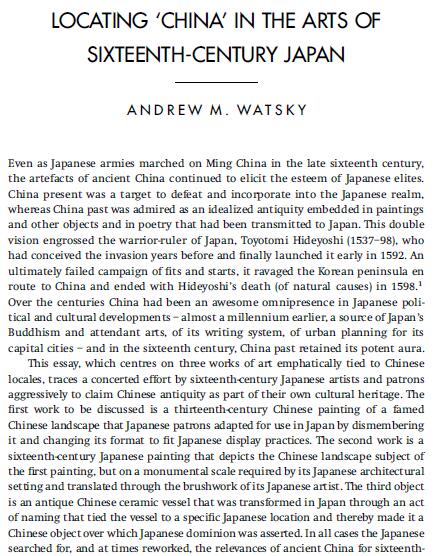Even as Japanese armies marched on Ming China in the late sixteenth century,
the artefacts of ancient China continued to elicit the esteem of Japanese elites.
China present was a target to defeat and incorporate into the Japanese realm,
whereas China past was admired as an idealized antiquity embedded in paintings
and other objects and in poetry that had been transmitted to Japan. This double
vision engrossed the warrior-ruler of Japan, Toyotomi Hideyoshi (1537–98), who
had conceived the invasion years before and finally launched it early in 1592. An
ultimately failed campaign of fits and starts, it ravaged the Korean peninsula en
route to China and ended with Hideyoshi’s death (of natural causes) in 1598.1
Over the centuries China had been an awesome omnipresence in Japanese political
and cultural developments – almost a millennium earlier, a source of Japan’s
Buddhism and attendant arts, of its writing system, of urban planning for its
capital cities – and in the sixteenth century, China past retained its potent aura.
This essay, which centres on three works of art emphatically tied to Chinese
locales, traces a concerted effort by sixteenth-century Japanese artists and patrons
aggressively to claim Chinese antiquity as part of their own cultural heritage. The
first work to be discussed is a thirteenth-century Chinese painting of a famed
Chinese landscape that Japanese patrons adapted for use in Japan by dismembering
it and changing its format to fit Japanese display practices. The second work is a
sixteenth-century Japanese painting that depicts the Chinese landscape subject of
the first painting, but on a monumental scale required by its Japanese architectural
setting and translated through the brushwork of its Japanese artist. The third object
is an antique Chinese ceramic vessel that was transformed in Japan through an act
of naming that tied the vessel to a specific Japanese location and thereby made it a
Chinese object over which Japanese dominion was asserted. In all cases the Japanese
searched for, and at times reworked, the relevances of ancient China for sixteenthcentury
Japan, and in all cases a central role in this process was played by location –
as revealed in such diverse conceptions as place name, poetry of place, artistic
conventions tied to place, even the actual earth of a place. Japan, conceptually and
physically, displaced China.


